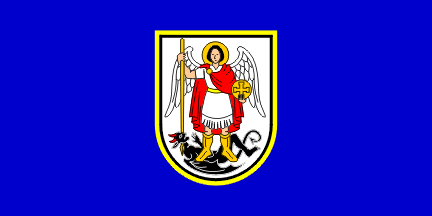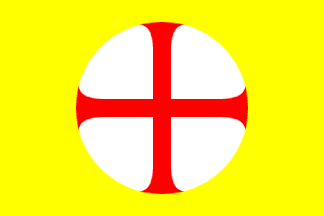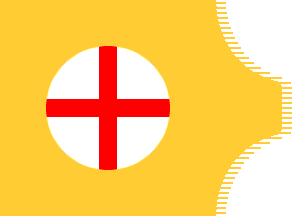
image by Željko Heimer, 24 July 2004

Last modified: 2008-07-05 by dov gutterman
Keywords: sibenik | knin | sibensko-kninska |
Links: FOTW homepage |
search |
disclaimer and copyright |
write us |
mirrors

image by Željko Heimer, 24 July 2004
See also:
Šibenik is the capital of the Šibenik-Knin county,
located at the confluence of Krka river into adriatic (forming
beautiful waterfalls). The city was, unlike many other Adriatic
cities not founded by ancient Romand, but was established in 10th
century under Croatian king Krešimir (Petar Krešimir
IV) who unlike any other previous Croatian ruler, build a strong
fleet that ruled Adriatic for a time.
The sources for symbosl are the official web site of the city
Službene stranice Grada Šibenika <www.sibenik.hr> (01.07.2003)
and my observation. The mdoern symbols are adopted on 22 may
1999.
The Coat of Arms of Šibenik originates in
the 13th century, and is preserved mainly on seals. It pictures
the patron of the city Archangel St. Michael (Sv. Mihovil)
wearing a white tunic and a red cloak, with his wings displayed,
holding in his sinister a golden orb with a cross and in his
dexter a golden spear with which he kills a black devil beneath
him.
The flag is blue with the yellow bordered coat of arms in the
middle. Ratio 1:2.
Željko Heimer, 24 July 2004
Update with data from official gazettes:
- Statut Grada Šibenika, 15.04.1994, Službeni vjesnik
Županije Šibenske, br. 4/94, 05.05.1994. - Includes a
provision describing the Coat of Arms (Article 6: shield
picturing St. Michael Archangel, patron of the old Šibenik),
without any further details. This does not necessarily mean that
it is talking about the same Coat of Arms design as used
currently.
- Pregled izvršenih isplata iz tekuce rezerve Proracuna za
1993. godinu, Službeni vjesnik Županije Šibenske,
br. 10/94, 01.09.1994. - The review of the budget spendings for
1993 includes an item: "Duje Šilovic - izrada
Prirucnika grafickih standarda za uporabu grba grada
Šibenika 1.100.281,- HRD", i.e. production of Graphical
Standards Manual for the Use of the Coat of Arms of the City of
Šibenik. I suppose that the Coat of Arms artwork was some
other then the current one officially adopted in 1999, but it may
as well be the same one. In the latter case, the designer might
be this Duje Šilovic.
- Odluka o grbu i zastavi Grada Šibenika, 24.07.1998,
Službeni vjesnik Šibensko-kninske županije, br.
14/98, 10.11.1998. Napomena uz Odluku o grbu i zastavi Grada
Šibenika, 30.10.1998, Službeni vjesnik
Šibensko-kninske županije, br. 14/98, 10.11.1998. - The
decision adopts the current symbols (possibly those already
comissioned in 1993?). The final prescriptions of the decision
determine that it shall be published only after the Ministry
approves the design, so the additional notice (Napomena) was
published citing the act of the Ministry approving it:
Rješenje Ministarstva uprave, klasa UP/I-017-02/98-01/35,
urbr. 515-04-03/1-98-2, 21.10.1998. Now the city web
site claims that the Coat of Arms and the flag were adopted
on the assembly session held on 20.05.1999 citying the official
gazette (Službeni list - is this the city gazette? or is it
misnamed county gazette?), but this seems contradictory. Also,
the city determined grants for use already in January and
February 1999! I therefore conclude that the site has errorneous
information or at least it must be some other exlanation.
- Statut Grada Šibenika, 27.11.2001, Službeni vjesnik
Šibensko-kninske županije, br. 18/01, 20.12.2001.- The
new statutes includes the description of the Coat of Arms and the
flag following the decision of 1998.
- Odluka o komunalnom redu, 23.07.2002, Službeni vjesnik
Šibensko- kninske županije, br. 12/02, 21.08.2002. -
The decision on communal order covers the question on hoisting
the flags in Šibenik: the flag of Croatia is hosited
according to the Law on the Coat of Arms, the flag and the anthem
(NN 55/90 and 26/93). The flag is hoisted on public areas during
the public holydays of the Republic, on the Šibenik Day, on
the mourning days and other legally established circumstances,
and could be hoisted on public assemblies (political, scienticif,
cultural, artistic, sport and others). The public areas for
hoisting are named - five main spots in the city and in other
settlements that are part of the citty territory according to
local regulations. Three of the spots are determined for the
hoisting all year round. Also flags are rised during the
International Children Festival. It is determined that beside the
flag of Croatia the flags of the County and the City could be
hoisted. The flag masts must be uniform, the flags are hoisted a
day before and lowered a day after the occasion. I suppose that
many other cities in Croatia have very similar regulations.
- Statut Grada Šibenika (procišceni tekst), 12.04.2006,
Službeni vjesnik Šibensko-kninske županije, br.
6/06, 28.04.2006. - The cleared text of the several times
amended statutes of 2001 does not have any amendments to the
description of the Coat of Arms and the flag, so it has the same
text as 2001.
The following several documents are conclusions granting
permitions for the use of the Coat of Arms to the Medical Bar,
the Tourist Office, the Parking Service, the Sports Association,
the Anti-cancer League and a private manufacturer of souvenirs:
Zakljucak o odobrenju Hrvatskom lijecnickom zboru -
Podružnica Šibenik, za korištenje grba Grada
Šibenika, 10.02.1999, Službeni vjesnik
Šibensko-kninske županije, br. 1/99, 08.03.1999.
Zakljucak o odobrenju Turistickoj zajednici Grada Šibenika
za korištenje grba Grada Šibenika, 20.01.1999,
Službeni vjesnik Šibensko- kninske županije, br.
1/99, 08.03.1999. Zakljucak o odobrenju za uporabu grba Grada
Šibenika Gradskom parkingu d.o.o. Šibenik, 11.05.2001,
Službeni vjesnik Šibensko- kninske županije, br.
6/01, 12.06.2001. Zakljucak o odobrenju uporabe grba Grada
Šibenika u znaku Saveza športova Grada Šibenika,
29.08.2001, Službeni vjesnik Šibensko- kninske
županije, br. 10/01, 14.09.2001. Zakljucak o odobrenju Ligi
protiv raka Šibensko-kninske županije za
korištenje grba Grada Šibenika, 08.05.2003,
Službeni vjesnik Šibensko- kninske županije, br.
5/03, 05.06.2003. Zakljucak o odobrenju Nelici Kneževic za
uporabu grba Grada Šibenika, 08.05.2003, Službeni
vjesnik Šibensko-kninske županije, br. 5/03,
05.06.2003.
Željko Heimer, 19 August 2006
As I have reported, Šibenik was using a different
coat of arms variation before 1999. On a city map issued by
the Šibenik Tourist Office, undated, but must be around
1995, this coat of arms is shown: This is, very probably, the
coat of arms refered in the 1993 budget I quoted in the previous
message, and if so, it is designed by Duje Šilovic, a
designer from Split. It seems that no flag with this coat of arms
was used. While the current coat of arms is based on the
depictions of St. Michael from the medieval stone carved seals
preserved in the city walls, the coat of arms version used in the
early 1990's is based on the olden preserved seal of Šibenik
from 1255, depicting St. Michael standing above the walls of the
city. (cf. various old seals shown at <www.sibenik.hr>).
Željko Heimer, 26 August 2006
The symbols were designed by the Heraldic
Art d.o.o. from Rijeka.
Željko Heimer, 3 November 2007
si-si.gif)
image by Željko Heimer, 24 July 2004
1980' Coat of Arms
In the socialsit period the historical coats of arms of the
cities depicting saints were depriciated and new symbols were
being made. The one used by Šibenik depicted the panorama of
the old city with fortresses, walls and the cathedral above the
waves and with a large red five-pointed star in the base
sinister. The shield was topped with the name of the city. No
flag was reported for the period.
Source: Šibenik Post Card, undated, around 1980.
Željko Heimer
1993-1998 Coat of Arms
si_si.gif)
image by Željko Heimer, 26 August 2006
While the current coat of arms is based on the depictions of
St. Michael from the medieval stone carved seals preserved in the
city walls, the coat of arms version used in the early 1990's is
based on the olden preserved seal of Šibenik from 1255,
depicting St. Michael standing above the walls of the city. The
artistic design of the coat of arms used in 1990's is probably
the one refered in the 1993 budget designed by Duje Šilovic,
a designer from Split.
It seems that no flag with this coat of arms was used.
Željko Heimer, 26 August 2006

image by Tomislav Todorovic, 24 August 2006
One of the oldest historical source for flag examination is
map. In monography of Historical Institute in Belgrade
"Monumenta Cartographica Jugoslaviae II" Narodna
knjiga, Belgrade 1979. author Gordana Tomovic compares different
XVIth century naval maps of Balkan peninsula. She notices flags
above some place names on map preserved in 'Bibliotheque National
in Paris (Departement des cartes et plans)' made on pergament by
Angelino Dulcert (1339a.d.):
13. Flag above town of Sibenik
(Sibinicho) - in today's Croatia [Colours are not mentioned.]
Ivan Sarajcic, 2 May 2000
I have recently found a full-colour photo of that map in a
book. The flag of Sibenik from the map of Angelino Dulcert has a
very large white disc, charged with a red cross, on the yellow
field. This colour combination is against the rules of heraldry,
but it also appears on other maps from that period, so it must be
based on the text and/or picture from "Libro del
conoscimiento de todos los Reynos", just like some other
flags with non-heraldic colour arrangements which also repeatedly
appear in these maps.
Source: Wigal, Donald: Historic maritime maps used for historic
exploration 1290-1699; Parkstone Press, New York, USA, 2000; ISBN
1-85995-750-1
Tomislav Todorovic, 24 August 2006

image by Tomislav Todorovic, 28 September 2006
Here is the image of this city's flag from the Catalan Atlas.
In the Catalan Atlas, Šibenik is represented with a flag
with a white disc, charged with a red cross, on the gold field.
This is essentially the same design as in the map of Angelino
Dulcert, the greatest difference being in the flag shape: a
square which extends into a short, wide tongue with concave
curved top and bottom edges; also, the disc is a bit smaller on
this flag and the cross has a simpler form, with straight arms'
edges.
As both flags share the colour arrangement which is against the
rules of heraldry, they might have both been based on "Libro
del conoscimiento de los reinos". It is also possible that a
flag with this design has really existed and that its description
came directly from some eyewitnesses: the design resembles the
form of the orb with the cross which is held by St Michael in the
coat of arms.
Tomislav Todorovic, 28 September 2006

image by Tomislav Todorovic, 18 July 2007
The flag of Sibenik on the map of Guillelmus Soleri, which was
created on Majorca c. 1385, and nowadays is kept in National
Library of France, Paris, is similar to that from the map of
Angelino Dulcert,but has a much more oblong form and the disc
with the cross is set off-centre, closer to the hoist.
Source: Wigal, Donald: Historic maritime maps used for
historic exploration 1290-1699 Parkstone Press, New York, USA,
2000 ISBN 1-85995-750-1.
Tomislav Todorovic, 18 July 2007